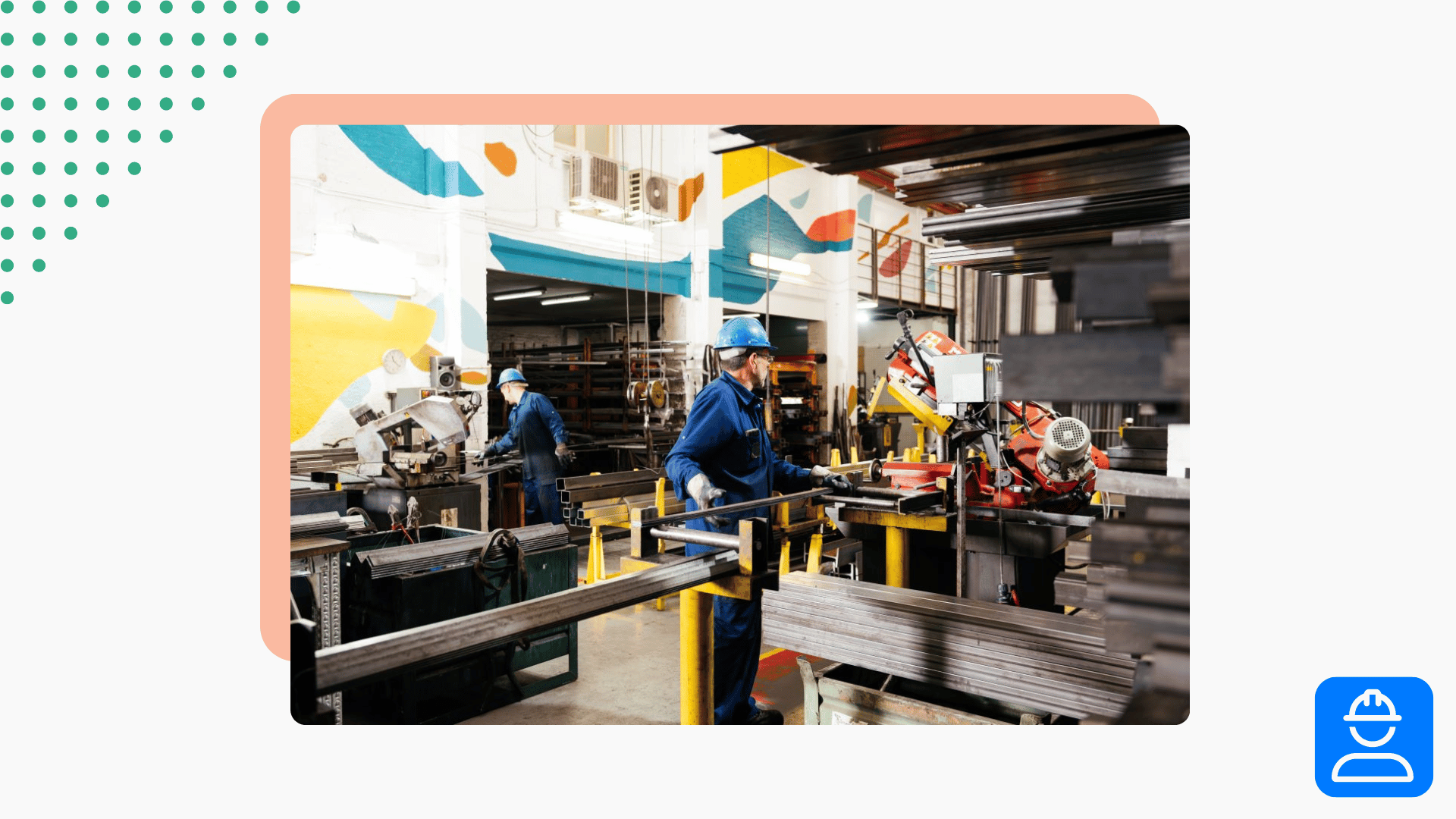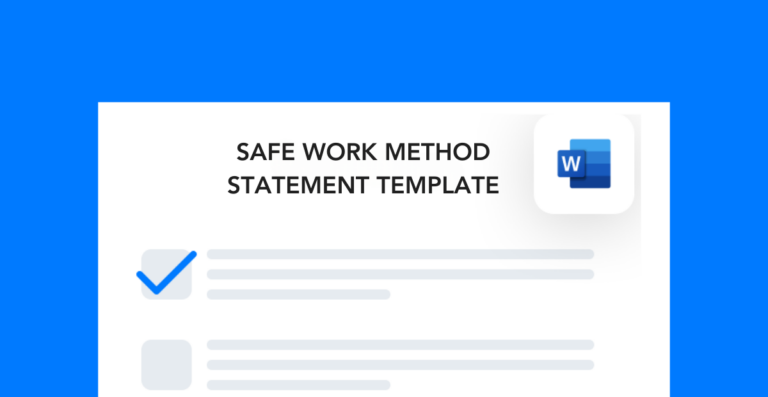Consistent communication is necessary to reinforce health and safety at work. Use these workplace safety tips in your next company newsletter or team meeting to promote safety at all levels.
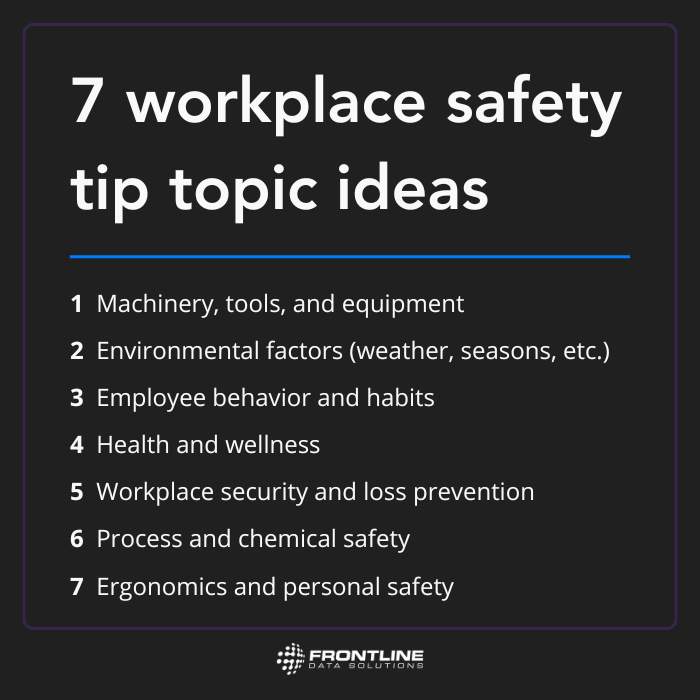
Seasonal safety tips
Environmental factors play a major role in workplace safety. These tips cover each of the four seasons, so your team stays prepared regardless of the weather.
Winter and autumn
- Always keep a spare set of clothes in your bag or car.
- Insulate your body by dressing in light layers underneath your heavier clothing.
- Consider wearing a face cover in cold temperatures to protect against wind burns.
- Keep a stockpile of salt on hand in case sidewalks become treacherous.
- Wipe your shoes or boots before you come into the building.
- During cold weather evacuations, huddle with your coworkers to stay safe.
- Double check that all the zippers and buttons on your winter coat are secure before winter arrives.
- Watch out for patches of ice by always keeping your eyes on the path.
- Avoid coming to work when you’re sick so you don’t spread it to others.
- During flu season, keep hand sanitizer at your workstation to prevent spreading germs.
- Even in the colder months when you’re not sweating as much, drink plenty of water to stay hydrated.
- Always hang up your coat and other belongings so they don’t become a trip hazard.
- Bring extra clothing to work during the cold months in case the temperatures drop suddenly.
- Stock up on sidewalk salt to make sure your walkways are always safe, even when it’s cold and icy out.
- Make sure that all gutters are clean and can divert water away from the building’s foundation.
- Wrap up all outdoor maintenance and improvement projects as autumn arrives so you can properly insulate and weatherproof the facility.
- Before the snow falls, remove speed bumps from the parking lot and fill any major cracks or potholes.
- Keep pedestrian walkways free of leaves and other debris.
- Get a professional inspection of your heating system before the temperatures drop too low.
- Fully stock outdoor emergency storage with heat blankets, flashlights, food, first aid kits, and more.
- Replace batteries in your flashlights and other weather emergency supplies.
- If decorating for the holidays, avoid fire safety hazards by ensuring that there are no exposed wires on string lights.
- When there are high winds or rain, secure outdoor furniture to make sure it doesn’t blow away.
- Report any stops signs, mirrors, guardrails, and other safety measures that need to be replaced or repaired.
Spring and summer
- Always check the weather before you leave the house, so you’re properly dressed and prepared.
- Invest in a pair of non-slip or composite toe work shoes to protect your feet against injury, especially when it’s wet and slippery outside.
- Stash an umbrella in your car for when it rains unexpectedly.
- Wear sunscreen, sunglasses, and a hat to prevent sunburn and overexposure symptoms.
- Put your PPE in a designated work bag and keep it in your vehicle (if applicable) so you never forget it.
- Stay on dedicated walking paths, especially when it’s muddy outside.
- Check that your shoelaces are tied and secure before climbing a ladder.
- Pack layers of clothing so you can take them off if the temperature rises.
- Report safety hazards immediately when you see them so management can fix them right away.
- Inspect door seals to make sure no bugs, rain, or other hazards get inside.
- Every spring, do a deep clean to get rid of broken or worn-out equipment.
- Know the emergency weather meeting place closest to your workstation.
- During your spring landscaping efforts, trim back any tree branches that might cause a hazard in high winds.
- Make sure that the cords to any of your fans are either out of walkways or sufficiently secured to the floor.
- When cleaning (especially dusty areas) wear a face mask.
- Consider reorganizing your workspace to better accommodate ergonomics.
- For outdoor work, opt for synthetic fabrics like polyester, spandex, and nylon which are more breathable and less likely to smell.
- Pack extra protein-rich snacks to stay full all day and prevent fatigue.
- If you’re feeling the symptoms of heat exhaustion, let management know right away so you can cool off and prevent heat stroke.
- Take additional breaks in hot weather to avoid overexertion and dehydration.
- Adjust your productivity expectations to accommodate increased risk of fatigue.
- Have a spare water bottle on hand so you can always stay hydrated.
- Try to limit your sugar and caffeine intake so you can prevent headaches.
- If allowed, bring a portable fan to the worksite to keep yourself cool during breaks.
- Opt for light colored clothing that doesn’t absorb the sun’s rays.
- Wear layers of clothing that are easy to take off and put back on.
- Reapply your sunscreen according to the SPF level.
- Take electrolytes regularly to avoid muscle cramps and dehydration.
- Wear a hat in the sun to protect your scalp from burns.
Equipment & tools
Follow these workplace equipment safety tips to ensure the careful use and management of tools and machinery.
Machine guards
- When working with adjustable guards, make sure that they’re properly calibrated to the task you’re doing.
- If you notice any loose or unstable components, let the maintenance team know right away.
- Apply lubricants to machinery according to the manufacturer’s instructions to keep it in good condition.
- Never attempt to jerry rig a machine guard at the risk of it flying off or becoming ineffective.
- When a machine guard is missing, do not attempt to use the equipment.
- For permanent machine guards, routinely check inspection records to make sure they’re safe.
- Clean machine guards, especially transparent ones, so you can verify that they’re secure.
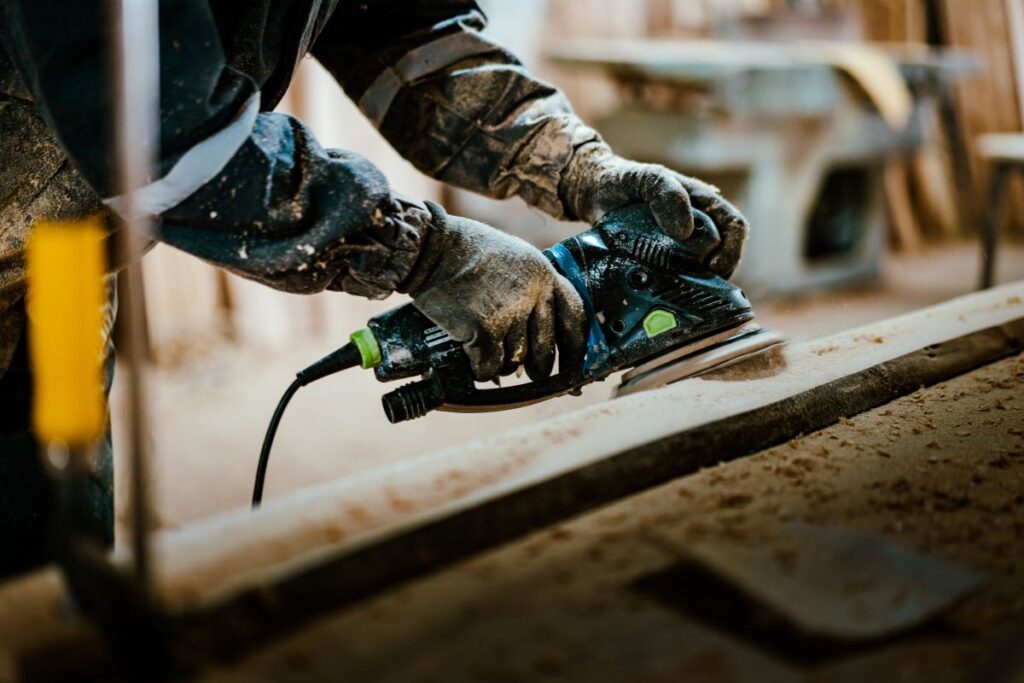
Stairways
- Use handrails to go up and down staircases.
- Never attempt to walk backwards on stairs.
- Don’t stop on the stairs to have conversations, always move to a safer spot.
- Keep the load you’re carrying close to your body while on the stairs.
- Stick to the right-hand side of the staircase.
- Carry items low enough that you can see over the top of them.
- When there are two lanes of traffic on a staircase, keep to the side and walk single file.
- Never run on the staircase at the risk of tripping or falling.
- Clean up spills promptly so that no one slips.
- Keep staircases clear of clutter and other obstructions.
- Wipe your feet on nonslip mats or carpet before ascending stairs on a rainy day.
Powered industrial trucks (PIT)
- Keep your PIT equipment clean by removing trash at the end of each shift.
- Always look both ways when you’re turning a corner or exiting an aisle.
- Conduct PIT inspection to look for mechanical issues before you start driving PIT equipment.
- Never attempt to pass underneath an object unless you’ve checked that you’ll clear the height first.
- Avoid putting anything on the overhead guard to prevent flying objects from hitting you or another person.
- Unclip your fall harness from the lanyard so that it doesn’t get stretched out.
- Never use your phone while operating a crane, reach truck, forklift, etc.
- Make eye contact with pedestrians to establish right of way.
- Make a complete stop before lifting or dropping off a load.
- Fill your PIT up regularly with fuel so it doesn’t get stranded.
- Use the horn at the end of aisles to notify people when you’re coming out.
- Maintain a safe distance between yourself and other PIT drivers.
- Focus on the path of travel and reduce distractions by not listening to music or talking while in motion.
- When stacking loads, keep them evenly distributed to avoid tip overs.
Powered tools/machinery
- When possible, use hand tools that are the correct orientation and size for your hands.
- Never store power tools where they can fall and break or cause someone to trip.
- Either red tag or throw out broken or damaged equipment.
- Check the area around you before you turn on energized equipment or set up a piece of machinery.
- Look behind you before swinging heavy equipment like a hammer or sledgehammer.
- When following the lockout tagout process, make sure you’ve notified other workers in the area that equipment is shut off.
- Always unplug hand tools when you’re not using them.
- Move any defective tools to a red tag area so the maintenance team can either fix or dispose of them.
Personal protective equipment (PPE)
- Replace your PPE when it’s damaged or worn out.
- Avoid using single-use PPE for multiple shifts.
- Inspect safety harnesses for tears, rips, broken grommets, and any other safety issues before each use.
- Bring extra PPE to your shift in case yours gets ruined or lost.
- Immediately replace any helmet or hard hat that has been involved in an impact.
- Secure your respirator by tightening the straps and double checking that the hoses connect properly.
- When working with corrosive materials, make sure you have eyewear and gloves to avoid chemical burns.
- At the end of every shift, hang up your fall harness to avoid tangles or damages.
- Wear safety headgear flat against the top of your head.
- Before driving PIT equipment, double check that your fall harness lanyard is attached to the anchor point.
- If your helmet has a chin strap to secure it in place, use it every time.
- During hot work activities, wear fire resistant gloves and a face shield to protect yourself from sparks and flames.
Industry-specific safety tips
These workplace safety tips cover the manufacturing, construction, and logistics industries.
Manufacturing
- Follow the 5S for each work area to ensure that everything stays in its place and it’s easy to find tools and materials when you need them.
- Dispose of hazardous materials according to your site’s guidelines and never leave them sitting out in the open.
- Never store items in front of the exits.
- Set up your workstation so you don’t have to bend and stoop to reach the materials and tools you use the most.
- Walk in designated areas to avoid getting hit by projectiles, PIT, or other hazards.
- Never store finished goods near hazardous materials like chemicals or open flames.
- Wear your hair tucked back so it doesn’t get pulled into machinery.
- Only enter a hot work area if you have a permit.
- Practice safe lifting techniques regularly to ensure your form is effective as possible.
- Encourage foot safety by offering workers a stipend for protective footwear.
- Keep all electrical components, chemical storage areas, etc., free of clutter, dust, and other potential combustion hazards.
- Know the location of the nearest first aid kit and eyewash station.
- Don’t stick your hands and fingers in between equipment parts unless the machine is locked out.
- Keep your ergonomic mat securely fastened to the floor to prevent slips.
- Before turning on equipment, double check that all the shields and guards are correctly in place.
- Log any maintenance work you do so it’s easier to track and diagnose mechanical issues.
- Lock out equipment before you attempt to complete any repairs or maintenance.
- For each process and piece of equipment, make sure you know the emergency shutdown mechanism or procedure.
- If your Andon light isn’t working, notify your manager right away.
- Wear protective eyeglasses or masks when working with sparks.
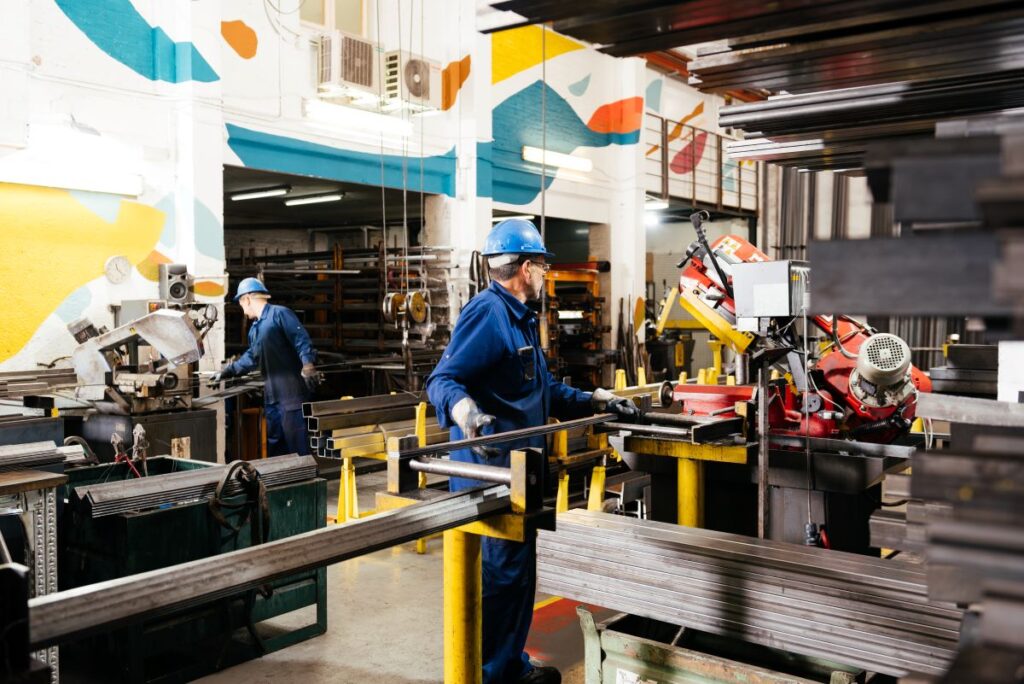
Construction
- Always inspect your equipment for safety concerns or mechanical failures before you operate it.
- Clean your boots and gloves often, so they have enough traction and grip.
- Secure the swing radius of crane equipment before operating it, especially in work areas with lots of traffic.
- Establish a firm grip on any equipment or materials before attempting to load or unload them.
- Make sure you’ve cleared the pathway before turning or backing up.
- Get in and out of the equipment cabin using steps or footholds to prevent falls.
- Use a spotter to maneuver in and out of tight or congested areas of the site.
- Never loiter in active work zones unless you need to be there.
- Always check the ground conditions around the construction site before you operate heavy equipment.
- Make sure you place ladders and scaffolding on solid ground to prevent them from tipping over.
- Only modify or repair equipment if you’re trained in how to do so.
- Use a toolbelt or a hoist system to move heavy materials and tools to a higher work area.
- Inspect PPE for tears, rips, and other signs of damage before each use.
- Steer clear of ladders and scaffolding that are in use and do not walk underneath them.
- Once your hard hat sustains an impact, replace it immediately.
- Keep hand tools, materials, personal items, and other potential trip hazards off the floor and out of walkways.
- Store chemicals according to the manufacturer guidelines.
- Eliminate trip hazards by keeping your work area clean throughout the day.
- Charge your radio, laptop, and other communication devices at the end of the day so they’re ready to go for the next shift.
- Don’t enter restricted areas unless you’re certified to be there.
- When you finish with a power tool, wrap up any loose cords and store the tool in its correct place.
- When a team lift is unavailable, consider using dolly straps to lift a heavy item yourself or wait for help.
- Use safety glasses while working with dust or potential projectile hazards.
- Take any machinery, tools, or other equipment in need or repair or replacement out of use.
- Review the emergency shutdown procedures for each task you perform.
- Only move a ladder or scaffold if there’s nothing and no one on it.
Logistics & warehousing
- Check your workstation for potential safety hazards before you start your activities for the day.
- Keep aisles and doorways clear of clutter, debris, and garbage.
- Wear gloves to protect your hands from cuts and burns.
- Never lean or sit on equipment like truck forks, conveyor belts, etc.
- Put your hair above your shoulders to avoid it getting pulled into machinery.
- When you’re done using a tool, put it back in its proper storage place.
- Keep all food and drinks (besides water) off the production floor.
- Never make changes or repairs to equipment/tools unless you’re trained in how to do so.
- Dispose of broken pallet pieces, nails, and other debris where they won’t injure anyone.
- Turn on a light when loading items in a dark trailer.
- Stack loads with the heaviest items on the bottom and the lightest items on top.
- Consider wearing safety shoes if your job involves lots of lifting.
- Always wear a high visibility vest on the production floor.
- Stay on designated walking paths so you don’t accidentally get hit by a PIT driver.
- Put enough tape on packed boxes to make sure they’re secure enough to lift and load.
- Use a step ladder to grab anything that’s above your eye level.
- Tuck away hair and loose clothing when working around moving parts.
- Get help from a coworker when an object is too heavy to lift alone.
- Let your EHS team know if you come across any suspicious materials.
- Don’t forget to put heavy labels on packed items so others can perform a proper lift.
- While driving, always maintain five points of contact.
- Keep your eyes on your direction of travel while driving PIT equipment.
- Report any missing or worn out stop signs that you see.
- Replace worn out and/or damaged PPE periodically.
- Put damaged or broken equipment in a designated storage area.
- Lock out any hazardous energy sources before performing tests or maintenance.
- Clean as you go so you don’t create any safety hazards unintentionally.
- Include emergency procedures on each piece of PIT equipment.
- Wash your fall protection harness on a regular basis.
- Make sure that all dock door seals are secure from water leaks during inclement weather.
- Check that ergonomic mats are properly secured to the floor.
- Follow the work area 5S to keep your station organized and clean.
- Never throw garbage in the recycling receptacles.
- Stop at the end of warehouse aisles to double check for oncoming traffic.
- Always know where the nearest exit, first aid station, and phone are located.
- Stretch thoroughly before every single shift to protect against injury.
- Carry a water bottle with you to prevent dehydration.
- Abide by all stop signs and speed bumps while driving around the facility.
- Secure all loose cables and cords out of walking areas to prevent trips.
Mining
- Keep an eye on the slope of excavation walls by measuring them regularly.
- Before turning on conveyor belts, make sure the cords don’t cause a trip hazard.
- Do a respirator fit check before each shift to ensure that your equipment is effective.
- Never enter a confined space without the proper permit.
- Perform air quality checks frequently throughout your shift.
- Keep all personal items, tools, and equipment safely stored out of harm’s way while working in a confined space.
- Block off restricted areas with tape or ropes to prevent uncertified workers or visitors from entering them.
- Inspect all PPE to ensure its effectiveness and so you can replace it if it’s not suitable.
- Make sure your communication equipment like radios, satellite phones, etc., has a full charge before each shift.
- Review the emergency response procedures routinely so you can make quick decisions.
- If you see a hazard and can’t fix it yourself, report it to management.
Free template!
Download this free template to establish the safe work method statement for any project or process within your site.
Body-specific safety tips
These workplace safety tips apply to different parts of the body and how to prevent injuries.
Head, face, and neck
- Wear sunscreen when working outside to protect your skin.
- Always wear an ANSI-approved helmet when required.
- Pull your hair away from your face and above your shoulders.
- Don’t pull items from an overhead bin unless you can see what’s inside.
- Inspect your hard hat before each shift.
- In cold temperatures, cover your neck with a gaiter to keep away wind chill.
- Wear safety glasses when there are potential projectile hazards.
- Inspect eyewash stations weekly to ensure they’re sanitary and easily accessible.
- Replace your eye safety gear when it becomes scratched or cracked.
- Use a step ladder to get on eye level with items you want to lift.
Hands and arms
- Letting falling items fall and avoid trying to catch them.
- Wear a lightweight, long sleeve top and sunscreen while working in direct sunlight.
- Keep your hands out of rotating machine parts like conveyor belt rollers or gears.
- Try to keep your nails to no longer than quarter inch, especially if working without gloves.
- Avoid wearing shirt sleeves, belts, etc., that may catch in machinery.
- Ensure that your gloves are the right fit, grip, and composition for the task.
- Don’t wear accessories like bracelets or rings that can increase the risk of degloving.
- Cut boxes, shrink wrap, and other materials away from your body.
- Keep your hands away from unguarded machinery and areas where you can’t see what’s inside.
- Use a C-grip and both hands to lift heavy or irregular objects.
- Avoid twisting your body to turn, especially when handling heavy items.
- Stretch your hands and arms out before making heavy lifts to prevent injuries.
- Utilize lift equipment like pallet jacks and forklifts when possible.
- Always check to make sure that machine guards are in place before using machinery.
Back, legs, and feet
- Never use your back to lift a heavy item.
- Squat with your legs to set down heavy items.
- Turn your feet instead of twisting with your torso.
- Keep your back as straight as possible when you’re sitting or lifting an item.
- When pushing a stacked load, make sure you can see in front of you or use a spotter.
- Utilize a team lift for any items that exceed your company’s safe lift maximum.
- Don’t lock your knees in place when standing for long periods of time.
- Make sure your shoes are appropriate for the work you’re doing.
- Carry heavy loads by keeping the weight close to your body.
- Keep tools and materials that you use often where you don’t have to reach for them.
- Stand with your feet shoulder width apart while making lifts.
- Break in new safety shoes before using them for an entire shift.
- Wear long pants at work to avoid getting any cuts or burns on your legs.

